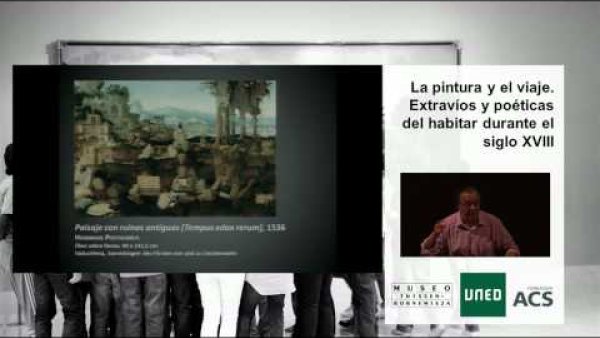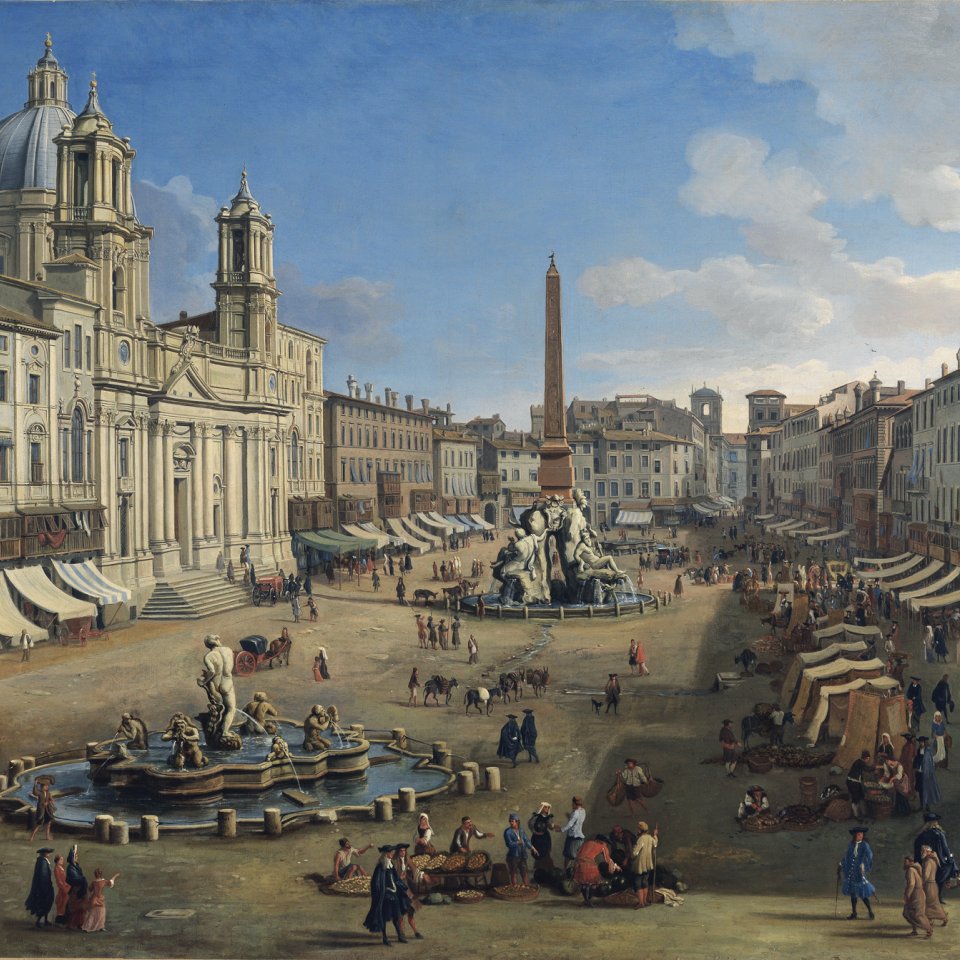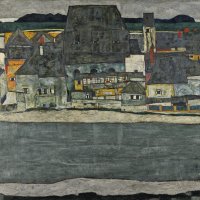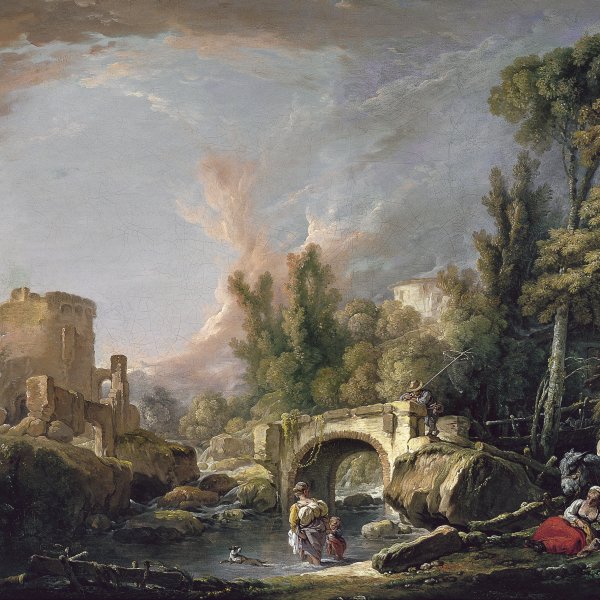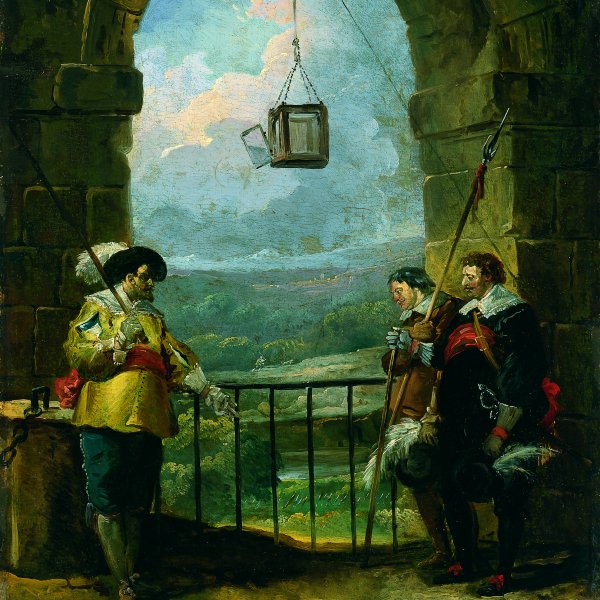Interior of the Temple of Diana at Nimes
Oil on canvas.
101 x 143 cm
Museo Nacional Thyssen-Bornemisza, Madrid
Inv. no.
343
(1978.43
)
ROOM 24
Level 2
Permanent Collection
Views of classical buildings and ruins based on the drawings that the artist made during his lengthy time in Italy occupied an important place within Hubert Robert’s repertoire of subjects. These youthful sketches, which Robert subsequently used with variations in his paintings, gained him the nickname of “Robert des ruines”. Works of this type reflect the interest of certain sectors of 18th-century French society for archaeology and the ancient world. Such French lovers of antiquity had discovered the great remains in Italy and Greece but had largely ignored the ones to be found at home. In the last third of the century this situation changed and we witness the first efforts to record, draw, engrave and paint the temples and other structures that survived from antiquity in France. Falling within this context is the important publication designed by the Marquis de Laborde, Voyage pittoresque de la France, which was intended to comprise twelve volumes but of which only four were published. Hubert Robert was also interested in French classical antiquity and in 1783, eighteen years after his return from Italy, he embarked on a project to paint classical buildings in Provence. He focused on structures such as the Roman temple known as the Maison Carré, the Tour Magne, the Arènes, and the Temple of Diana, all in Nîmes, as well as the Pont du Gard between Avignon and Nîmes. It is not known who conceived of this project, which may have been Robert’s own idea or a commission.
Interior of the Temple of Diana at Nîmes is signed and dated 1783 and was formerly in a private collection in Paris. It was also in the Paris collection of Paul Cailleux and in the collection of Graf Finck von Finckenstein, before passing to the Carroll gallery in Munich from whom it was acquired in 1978 for the Thyssen-Bornemisza collection.
Using a high viewpoint Robert introduces us to the ruins of this temple, which are enlivened with a series of figures including a traveller, a busy artist seated on a block of stone and various figures wearing classical tunics who, in the case of the one on the right, seem to be acting out an episode to the public. We also see two men dressed as soldiers and in the background inside the temple two figures engaged in some sort of rite or ritual. The interior of the temple is crowded with fragments of columns that have been piled together for storage, as well as capitals, column bases and remains of pediments piled up and arranged, and tombstones leaning against the far wall. The spot is an ideal one for the curious observer, and Robert depicts two figures standing on the roof looking down on the scene and others peering out between the arcading.
Two drawings of the Temple of Diana are known, a wash, and a watercolour that forms a pair with a view of the Maison Carré. The Musée du Louvre has a version of the interior of the temple dated 1787 in which Robert has reduced the angle of vision on the right and in which he modifies the position of the architectural and sculptural fragments as well as the figures visiting the building. The present canvas has been paired with the Maison Carré in Nîmes, of which there are various versions. Among the best known is the painting in the Pavlovsk Palace Museum, St. Petersburg.
Mar Borobia
Interior of the Temple of Diana at Nîmes is signed and dated 1783 and was formerly in a private collection in Paris. It was also in the Paris collection of Paul Cailleux and in the collection of Graf Finck von Finckenstein, before passing to the Carroll gallery in Munich from whom it was acquired in 1978 for the Thyssen-Bornemisza collection.
Using a high viewpoint Robert introduces us to the ruins of this temple, which are enlivened with a series of figures including a traveller, a busy artist seated on a block of stone and various figures wearing classical tunics who, in the case of the one on the right, seem to be acting out an episode to the public. We also see two men dressed as soldiers and in the background inside the temple two figures engaged in some sort of rite or ritual. The interior of the temple is crowded with fragments of columns that have been piled together for storage, as well as capitals, column bases and remains of pediments piled up and arranged, and tombstones leaning against the far wall. The spot is an ideal one for the curious observer, and Robert depicts two figures standing on the roof looking down on the scene and others peering out between the arcading.
Two drawings of the Temple of Diana are known, a wash, and a watercolour that forms a pair with a view of the Maison Carré. The Musée du Louvre has a version of the interior of the temple dated 1787 in which Robert has reduced the angle of vision on the right and in which he modifies the position of the architectural and sculptural fragments as well as the figures visiting the building. The present canvas has been paired with the Maison Carré in Nîmes, of which there are various versions. Among the best known is the painting in the Pavlovsk Palace Museum, St. Petersburg.
Mar Borobia

